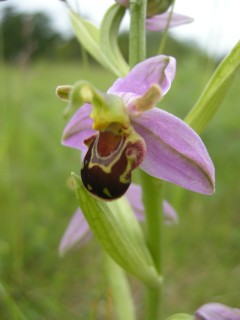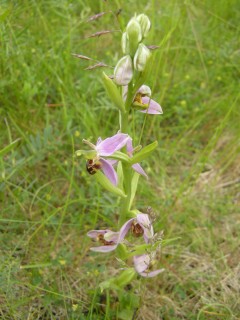Position: Full sun to partial shade
Flowering period: Late spring to early summer
Soil: Moist, well drained
Eventual Height: 50cm
Eventual Spread: 10cm
Hardiness: 7b, 8a, 8b, 9a, 9b, 10a, 10b
Family:Orchidaceae
Ophrys apifera is a low growing tuberous herbaceous perennial. Its mid green leaves are ovate or oblong/ lanceolate and appear in rosettes during the winter months. Its flowers emerge from spikes and are arranged in groups of up to 12. The median lobe of the flower is similar to the abdomen of a bee, being brow/ red with yellow markings.
Ophrys apifera, commonly known as the Bee Orchid, is native to most of Europe, being common in the Mediterranean region and uncommon in the north of its range (including the UK, particularly in the southeast). In the plants southern range the plant is pollinated by the solitary bee. The plant attracts the male bee by producing the scent of a female bee any by the median lobe of the flower being similar to the female bee. In the north of its range it is self-pollinated. In its natural habitat it generally grow on limestone or calcareous sand soils, within a dry meadow flora. Ophrys apifera is synonymous with Orchis apifera and Arachnites apifera.
The etymological root of the binomial name Ophrys is derived from the Greek ὀφρύς meaning ‘eyebrow’. Apifera is derived from the Latin apis meaning ‘bee’ and fero meaning ‘to bear’, referring to the bee shaped lip.
The landscape architect may find Ophrys apifera useful for naturalising this British native into areas of wild flower meadow.
Ecologically, Ophrys apifera are pollinated by solitary bees.
Ophrys apifera prefers moist, well-drained soils. It tolerates most pH of soil, although it prefers an alkali pH.
Ophrys apifera requires little maintenance.






Leave a comment